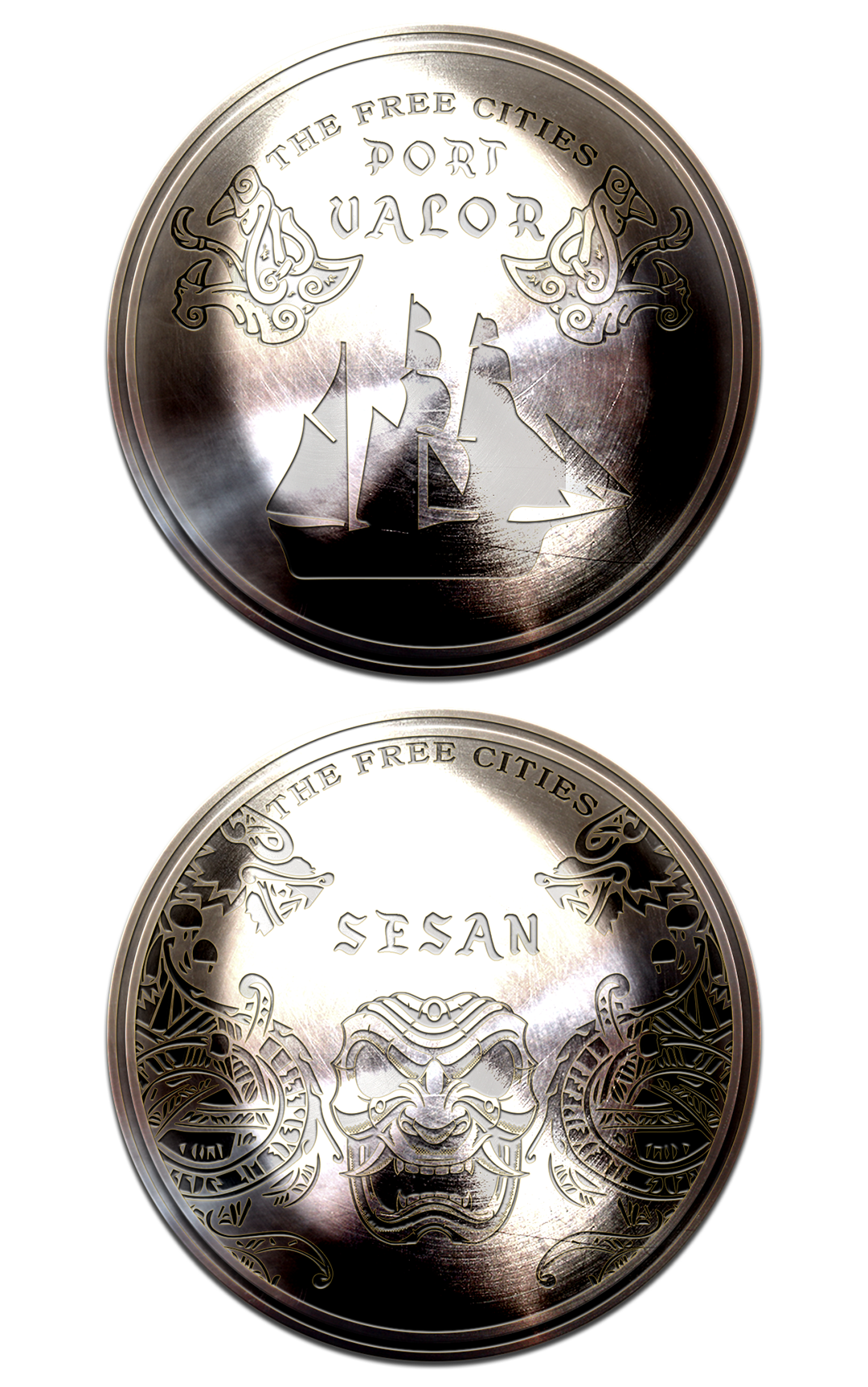Cruix
The Cruix is the only physical currency traded within the Free Cities. Each city mints their own Cruix, usually decorated with symbos or a landmark that the city is known for. While used and accepted in every free city, Cruix have very little value outside of their jurasticion and often serve as memorabilia from travels or as gifts.
Mechanics & Inner Workings
All legally minted Cruix must be numbered in accordance to a certain cache of platinum that is within the Platinum Standard. Specific records are kept by the Free Cities Bank and the Free Commerce Committee who perform regular checks to ensure the standard is adhered. The mints are overseen by Pacificatores to enforce the law and investigate wrongdoings and misconducts.
History
In the early 11th century, the Free Cities Board of Directors attempted to ensure coins from Berri Sesan and Port Valor, the three biggest free cities, could be traded.
The board, through the Free Commerce Committee proposed a standard that would replace the existing arbitrary, separately minted coins with a coin of unified shape, size and material. Each coin was to be minted in accordance to a number registered to an amount of gold in the minting city or bank's treasury.
Implementation of the new standard proved difficult. The most prevalent issue was that the etching process had to be done by hand or with the help of crude tools. Some minters attempted to hire jewelers and artificers for the etching process, but that proved to cost more than the material's worth. If there was a mistake on the face of a coin it would have had to be destroyed and recycled, but few actually followed through with the practice due to the already high costs. Instead, they would remake the same one without throwing away the original. This led to many of the coins to have doubles in circulation.
Banks and minters received lists containing ranges of numbers that were permitted for use in their coins, but many had to mint more coins than their quota allowed for, creating doubles for numbers already provided to other organization. In some cases, the lists themselves were stolen or copied by rogue agents for making counterfeit money.
The Cruix is named Emil Cruix an alchemist and original founder of Cruix Alchemical Industries who invented the unique coin etching technique used in its minting process.
While attempting to find a way to purify silver shavings from contamination to sell as spell ingredients, Cruix accidentally splashed some of the solution on a piece of wax paper that was placed on an iron slab. He returned to his laboratory the morning after to discover that his experiment failed. When gathering his notes he noticed the wax paper completely dissolved on the iron slab, and that his writings have been perfectly etched into the iron.
Cruix spoke to his friend Ralf Merferd, a prominent metal-smith in Port Valor about the discovery, hoping he would help him refine the formula to properly remove the contamination. To his surprise, Merferd was more interested in the etched iron slab. A few years prior he opened a small mint hoping to compete in the growing market. He offered Cruix a partnership for the formula, which Cruix supposedly promptly refused, citing he wanted noting to do with the banking industry. Regardless, he returned to his laboratory and refined the process. He then licensed the formula to Merferd Mints for an undisclosed sum.
The Cruix quickly became popular among the general public. Mostly due to the various intricate patterns and designs used by Merferd Mints. The lack of regulation allowed for many unique variants to be distributed, garnering a following of collectors and enthusiasts who waited eagerly for new mints. Traders and tourists who visited Port Valor quickly spread the coin to other cities, where mints would contact Cruix to license his formula as well. In attempt to overshadow and differentiate themselves from the original coin more ludicrous and strange designs began to emerge around the continent with each bank and mint using a different brand name of their choice in hope the general public will buy their over their competitors.
Illegal variation of the iron coin became so common, the FCC had to intervene and set limitations on how designs can vary. Initially, Cruix licensed the formula separately to each mint with very little oversight but seeing the chaos it brought to the market, he donated the formula to the FCC prior to his death in 1054, so they can use it indefinitely and change it should the need arise. In their intervention, the FCC officially named the coin as Cruix in his honor and unified the design, creating a lasting minting standard that would change only once more when the Platinum Standard was adopted.
Significance
The Cruix play an important role in the lives of the Free Folk. Aside from it being used as as their main currency, the Cruix also holds sentimental value. Unlike other coins which are minted by a nationally owned facility or a monarch, anyone can mint a Cruix as long as their coin adhere to the codes and they are able to afford the platinum listed for their desired numerical allocation.
This loose approach has allowed the creation of countless mints around the Free Cities who each create their own designs and eventually sell them to banks to be used in circulation. In it not uncommon for individuals to procure such license to promote their agendas, brands, ideas or even simple jokes and pranks. Cruix are also often used in commemoration of important events that happen in a free city and distributed in a limited circulation, with collectors sometimes willing to pay hefty sums for particularly rare one.
Current Date: 2nd of Latsum, 1572
Trade Symbol
C
Creation Date
1121
Subtype / Model
Manufacturer
Creator
Related Technologies
Related ethnicities
Owning Organization
Rarity
Common
Weight
0.50 lbs / 1g
Dimensions
20mm
Base Price
1C (0.00045Pp)




Comments